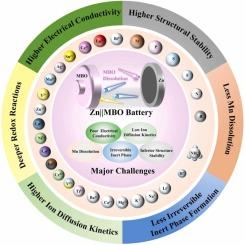锌离子电池中锰基氧化物阴极的离子掺杂与插层策略研究进展
IF 17.1
1区 材料科学
Q1 CHEMISTRY, PHYSICAL
引用次数: 0
摘要
在各种储能系统中,水锌离子电池(azib)由于其高理论容量、高成本效益和环境友好性而被广泛认为是一种有前途的选择。同样,锰基氧化物(MBO)由于具有理想的比容量和环保性质,作为azib的合适正极材料而受到欢迎。然而,这些材料也面临着诸如导电性差、离子扩散动力学低、锰溶解、结构稳定性差、不可逆惰性相形成等各种挑战。探索了缺陷工程、表面涂层、电解质优化、形貌控制和复合等策略。其中,离子掺杂和插层策略因其制备工艺简单、改性效果好而得到广泛应用。本文深入研究了MBO阴极在azib中的工作机理,综合选择了目前存在的挑战,并阐明了通过离子掺杂和插层来提高电化学性能的修饰机制。最后对今后的研究提出了建议和展望。本文章由计算机程序翻译,如有差异,请以英文原文为准。

Review of ion doping and intercalation strategies for advancing manganese-based oxide cathodes in aqueous zinc-ion batteries
Among various energy storage systems, aqueous zinc-ion batteries (AZIBs) are widely regarded as a promising option due to their high theoretical capacity, cost-effectiveness, and environmental friendliness. Similarly, manganese-based oxides (MBO), with their desirable specific capacity and eco-friendly nature, have gained popularity as a suitable cathode material for AZIBs. Nonetheless, these materials also face various challenges like poor electrical conductivity, low ion diffusion kinetics, manganese dissolution, inferior structural stability, and irreversible inert phase formation. Strategies like defect engineering, surface coating, electrolyte optimization, morphology control and compositing have been explored. Notably, ion doping and intercalation strategy has been widely applied for their easy fabrication process and effective modification effect. This review delves into the working mechanism of MBO cathodes in AZIBs, comprehensively discusses the existing challenges, and elucidates the modification mechanisms aimed at enhancing electrochemical performance through ion doping and intercalation. Some recommendations and outlooks are also provided for future research at the end.
求助全文
通过发布文献求助,成功后即可免费获取论文全文。
去求助
来源期刊

Nano Energy
CHEMISTRY, PHYSICAL-NANOSCIENCE & NANOTECHNOLOGY
CiteScore
30.30
自引率
7.40%
发文量
1207
审稿时长
23 days
期刊介绍:
Nano Energy is a multidisciplinary, rapid-publication forum of original peer-reviewed contributions on the science and engineering of nanomaterials and nanodevices used in all forms of energy harvesting, conversion, storage, utilization and policy. Through its mixture of articles, reviews, communications, research news, and information on key developments, Nano Energy provides a comprehensive coverage of this exciting and dynamic field which joins nanoscience and nanotechnology with energy science. The journal is relevant to all those who are interested in nanomaterials solutions to the energy problem.
Nano Energy publishes original experimental and theoretical research on all aspects of energy-related research which utilizes nanomaterials and nanotechnology. Manuscripts of four types are considered: review articles which inform readers of the latest research and advances in energy science; rapid communications which feature exciting research breakthroughs in the field; full-length articles which report comprehensive research developments; and news and opinions which comment on topical issues or express views on the developments in related fields.
 求助内容:
求助内容: 应助结果提醒方式:
应助结果提醒方式:


